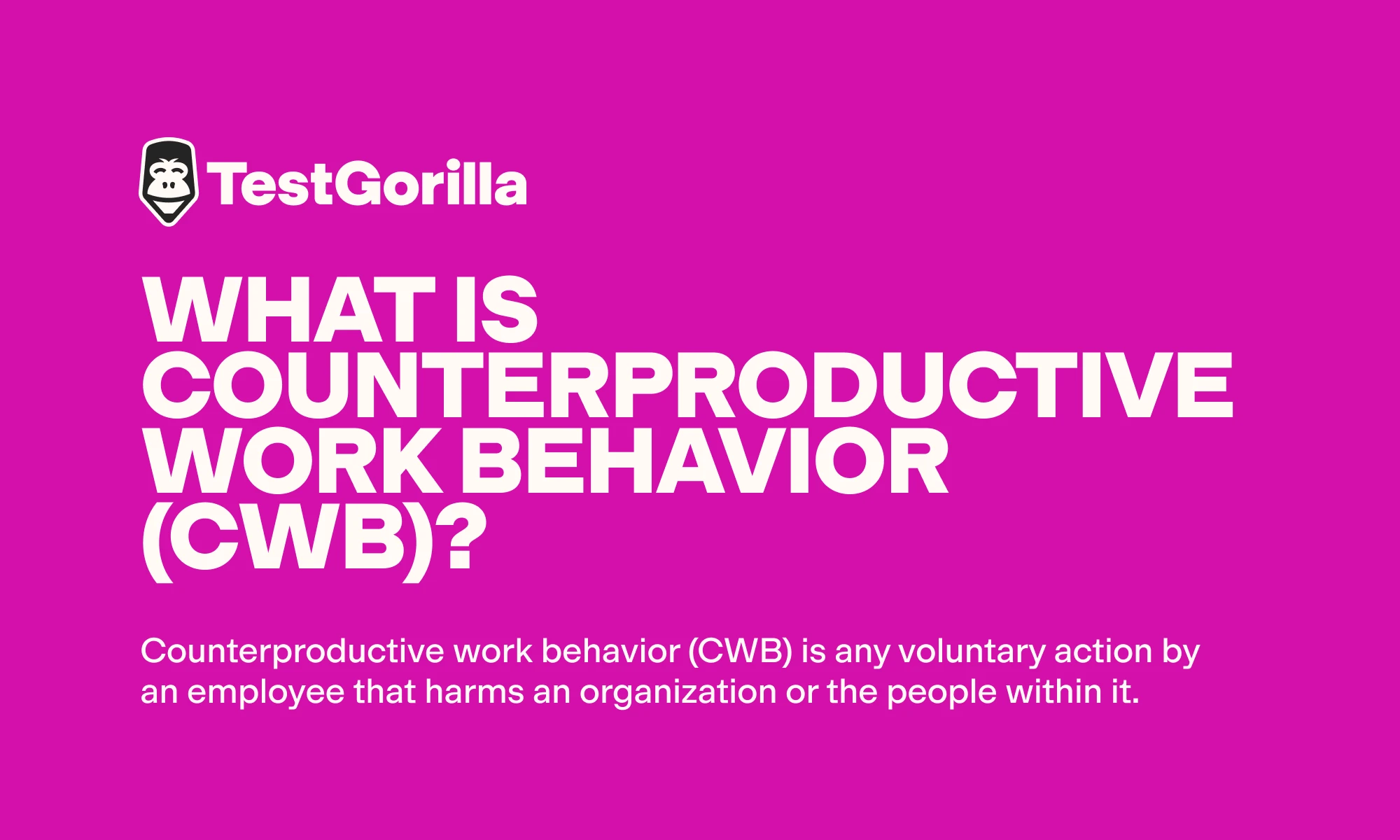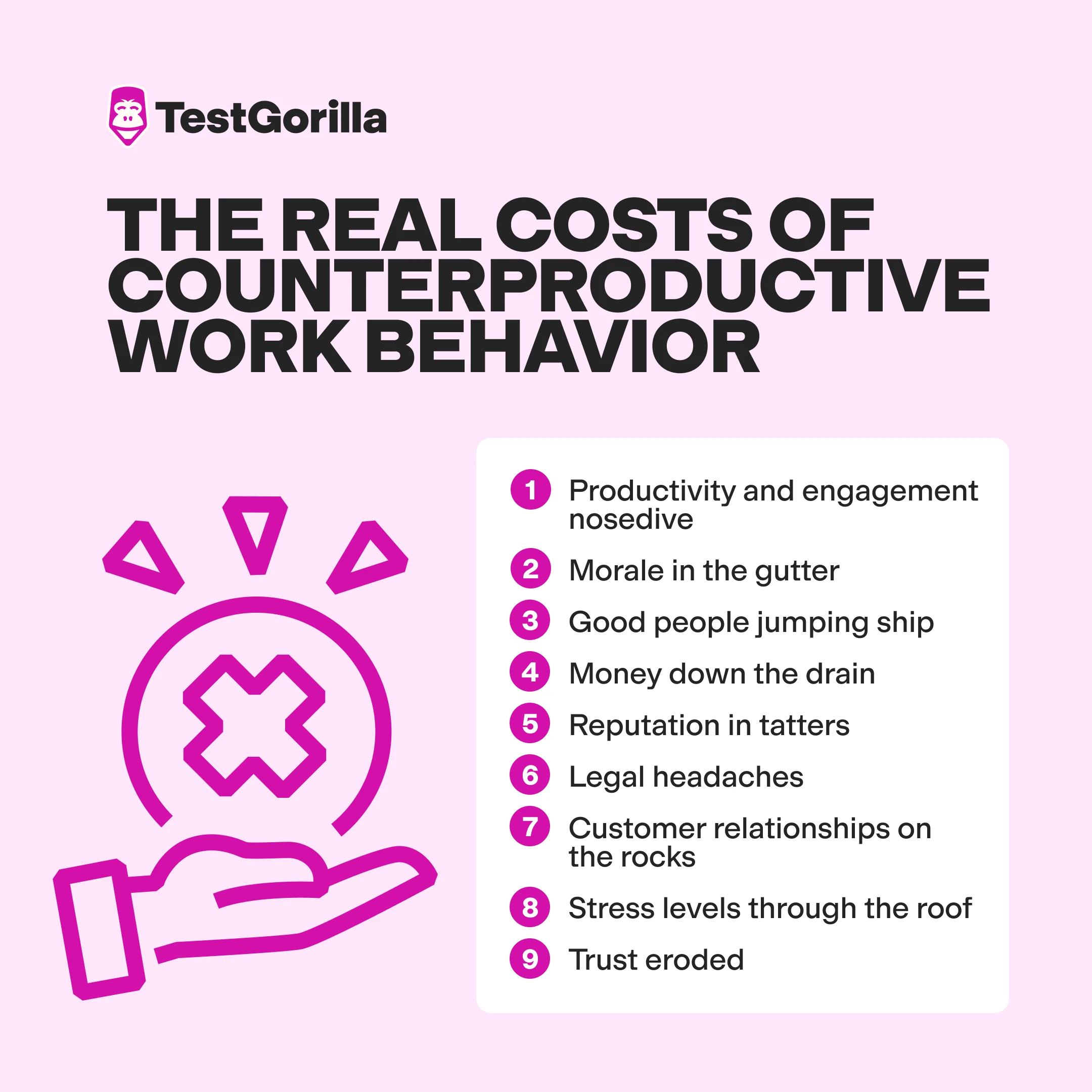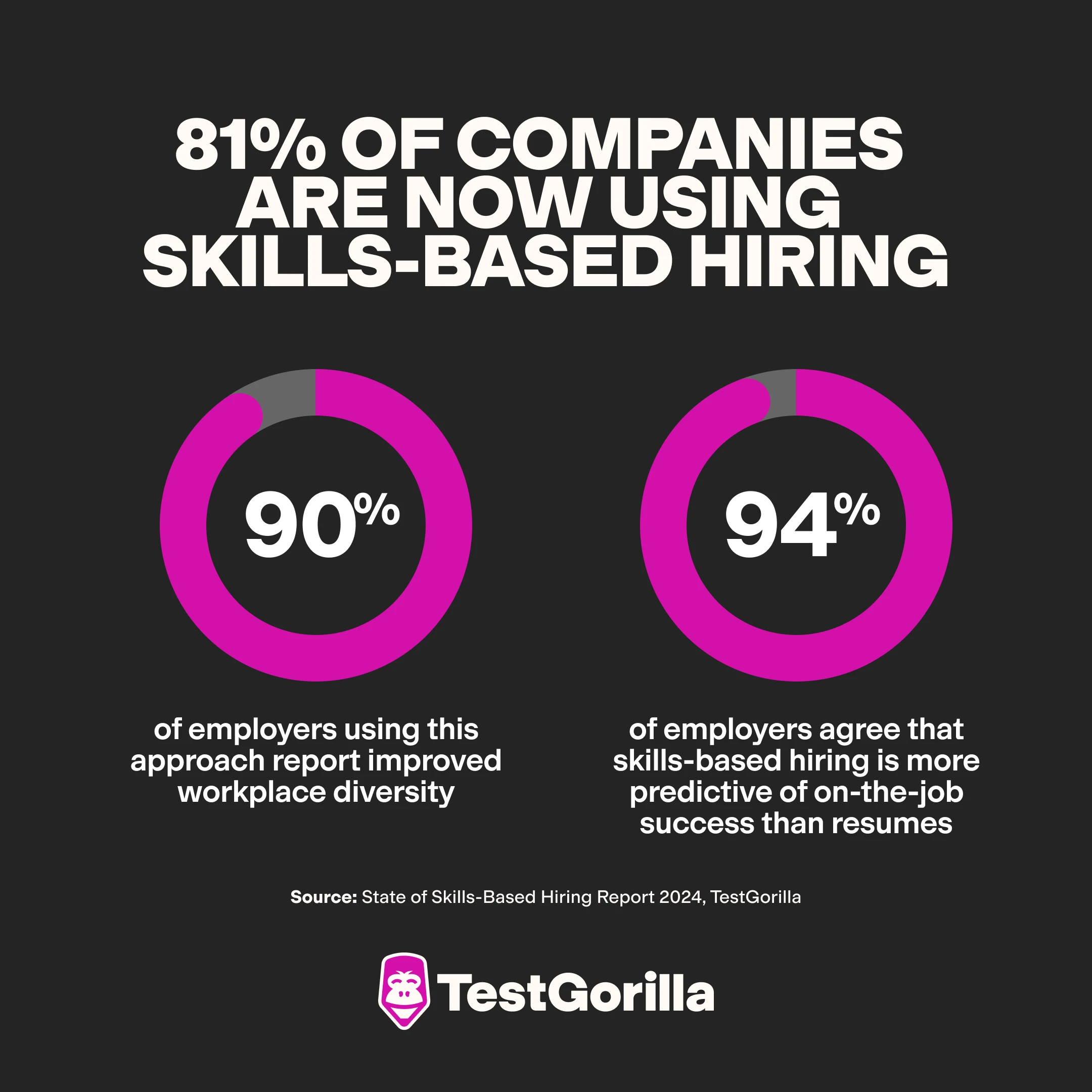What is counterproductive work behavior (CWB)? + How to fix & prevent it
Ever caught an employee swiping office supplies? Have you noticed a team member regularly slacking off? If so, you’re witnessing counterproductive work behavior (CWB).
CWB can crop up in several ways for various reasons – and it seriously impacts your company's productivity, morale, and more.
But don’t panic – we have your back. In this guide, we break down what CWB is, why it happens, and how to stop it. Plus, we'll show you how to build a team that's less likely to cause trouble in the first place.
Table of contents
- Key takeaways
- What is counterproductive work behavior?
- Counterproductive work behavior: What does it look like?
- The real costs of CWB
- Why employees go rogue: The causes of CWB
- Tackling CWB head-on: Your action plan
- Stop CWB before it starts: Building a stronger workplace
- Use skills-based hiring and prevent CWB with TestGorilla
- FAQs
Key takeaways
Counterproductive work behavior (CWB) includes actions that harm organizations or people within them, like theft, bullying, or slacking off.
It can tank productivity, wreck team morale, and cost your company revenue.
Addressing CWB involves clear communication, fair policies, and a supportive work environment.
Preventing CWB starts with smart hiring. Use skills-based assessments to find candidates who fit your company’s culture.
What is counterproductive work behavior?
Counterproductive work behavior (CWB) is any voluntary action by an employee that harms an organization or the people within it.
We aren’t talking about honest mistakes or having an off day – these are intentional actions that go against company goals and values. CWB is behavior that actively undermines the workplace, whether through damaging property, sabotaging work, or creating a hostile environment for others.
The best insights on HR and recruitment, delivered to your inbox.
Biweekly updates. No spam. Unsubscribe any time.
Counterproductive work behavior: What does it look like?
Counterproductive work behavior can take many forms, from the subtle to the dramatic. Here are examples of CWB:
Absenteeism. This goes beyond the occasional sick day. It's when employees regularly skip work without good reason, leaving their coworkers to pick up the slack.
Theft. This can be anything from stealing office supplies to fiddling with time entries, expense reports, etc. Even using company resources for personal tasks counts as theft.
Slacking off (or quiet quitting). Also known as production deviance, this is when employees deliberately work below their capacity. Think excessive personal internet use or long breaks.
Sabotage. This can be anything from intentionally withholding essential information from coworkers to purposely damaging equipment.
Bullying or harassment. It can be verbal, physical, or even digital (such as through offensive emails or messages), often targeting specific individuals or groups. Bullying and harassment are two types of interpersonal deviance.
Gossip and rumor-spreading. While it might seem relatively harmless, malicious talk (another type of interpersonal deviance) can damage reputations and stir up unnecessary conflict at work.
Misusing company time. This involves conducting personal business during work hours, like running a side hustle or job hunting on the clock.
Violating safety procedures. This can put the individual at risk, endanger coworkers, and lead to costly accidents.
Insubordination. This is when an employee refuses to follow reasonable instructions from supervisors or deliberately undermines authority.
The real costs of CWB
The effects of counterproductive work behavior can ripple through an organization, causing both immediate and long-term damage. Let's break it down:
1. Productivity and engagement nosedive
Counterproductive work behaviors like frequent tardiness, extended breaks, and intentional work slowdowns all contribute to reduced productivity and signal low engagement. This can cost your business a ton of money. In fact, low employee engagement levels are estimated to cost the global economy $8.9 trillion per year.
2. Morale in the gutter
Counterproductive work behavior creates a toxic atmosphere that can infect even your most positive employees. When team members see others engaging in – and often getting away with – bad behavior, resentment builds while motivation tanks.
3. Good people jumping ship
High-performing employees often quit to escape environments plagued by CWB. This turnover can be incredibly costly, as replacing an employee can set you back months of their salary.
4. Money down the drain
The financial hit of counterproductive work behavior can be substantial. Organizations lose an average of 5% of their annual revenue to fraud alone – and that's just one type of CWB.
5. Reputation in tatters
CWB that affects customers can quickly become public, tarnishing your brand. This kind of damage can stick around for a long time.
6. Legal headaches
Some forms of CWB, like sexual harassment or safety violations, can land your company in legal trouble. Even if you win, the legal fees and bad press can sting.
7. Customer relationships on the rocks
Counterproductive work behavior can directly impact customer service quality. Disengaged employees provide poorer service, potentially driving business away.
8. Stress levels through the roof
Dealing with CWB creates extra stress for managers and HR team members, potentially leading to burnout among those trying to address these issues.
9. Trust eroded
Persistent CWB can chip away at trust between employees and management, making it harder to implement changes or initiatives down the line.
Why employees go rogue: The causes of CWB
With so many clear ramifications of counterproductive work behavior, you need to know the potential reasons behind it. Here are the main ways CWB can begin to take hold:
1. Low job satisfaction
Research has found that job satisfaction and organizational commitment negatively correlate with CWB. This means happy, committed employees are less likely to cause trouble, and unsatisfied employees are more likely to act out. Such unhappiness can come from feeling undervalued, stuck in a dead-end job, or struggling with work-life balance.
2. Unfair treatment
When workers feel they're being treated unfairly, they might strike back through CWB. This could be about pay, promotions, workload, or how rules are applied. Fairness in processes and outcomes is important for keeping things positive at work.
3. Toxic environment
A negative work environment can make bad behavior seem normal. If employees see others engaging in and, particularly, getting away with CWB, they might think it’s okay or even necessary to fit in at work.
4. Feeling checked out
Disengaged workers often don’t care about the fallout from their actions and can be more likely to display CWB. With only a third of employees worldwide feeling engaged, this is a huge issue.
5. Burnout
Overworked employees might turn to counterproductive work behavior as a way to cope with stress, anxiety, and overwhelm.
6. Personality clashes
Some people are just more likely to engage in CWB due to their personality traits. Research shows that certain traits, such as low conscientiousness and high neuroticism, are linked to higher rates of CWB. The use of personality tests in the hiring process can help you identify potential team players or problem team combinations.
7. Poor job fit
When employees are in roles that don’t match their skills, interests, or values, frustration can lead to acting out.
8. Fuzzy expectations
Employees who aren’t sure what’s expected of them might accidentally engage in CWB. Clear job descriptions and regular feedback are must-haves to prevent this behavior.
9. Organizational upheaval
Big changes like mergers, layoffs, or restructuring can create uncertainty and stress, potentially leading to CWB as employees try to protect themselves or express frustration.
10. Leadership fail
Poor leadership, especially abusive or highly controlling management styles, can provoke employees to push back through CWB.
Tackling CWB head-on: Your action plan
There are ways you can address counterproductive work behavior if it’s already an issue in your company. Here are 10 steps you can take:
1. Document it
Keep detailed records of incidents and their impact. This gives you concrete examples to discuss and helps identify patterns or triggers. Plus, if disciplinary action becomes necessary, you'll have the paperwork to back it up.
2. Talk it out
Address the issue directly with the employee in a private, confidential setting. During your conversation, focus on discussing specific behaviors rather than making character judgments. Let the employee share their side of the story. Then, clearly outline the impact of their actions.
3. Dig deeper
Find out why the employee is engaging in CWB. Ask open-ended questions like “What factors do you think might be contributing to this situation?” and listen without judgment. Consider factors like job stress, personal issues, or workplace conflicts that might be driving the behavior.
4. Offer a helping hand
Provide resources like counseling or training if needed. This could include Employee Assistance Programs for personal issues, skills training if there's a capability gap, or conflict resolution services for interpersonal problems.
5. Set clear expectations
Make sure the employee knows exactly what needs to change. Define specific, measurable behavior changes, such as “arriving on time for all scheduled shifts” or “completing assigned tasks within agreed-upon deadlines.” Then, establish a timeline for improvement, and discuss potential consequences if things don’t get better.
6. Follow through
If the behavior continues, implement disciplinary measures. This might include warnings, performance improvement plans, or more serious action in severe cases.
7. Keep tabs
Don't assume the issue is resolved after one conversation. Schedule regular check-ins to acknowledge improvements, quickly address backsliding, and provide ongoing support.
8. Learn and improve
Use the experience to strengthen your workplace procedures. Update your employee handbook with clearer guidelines on expected behavior and consequences for CWB. You might add sections on the proper use of company resources or expand existing policies on workplace conduct.
Additionally, provide your team with training on appropriate workplace behavior, and implement systems to catch CWB earlier.
9. Look at the big picture
If CWB is widespread, look for organizational factors that might contribute to it. These could include unclear job expectations, perceived unfairness in promotions or assignments, or a lack of recognition for good work. To do this, conduct employee surveys, review policies and procedures, and assess leadership effectiveness.
10. Celebrate wins
When employees successfully correct CWB, recognize their efforts. This reinforces good behavior and shows others that positive change is possible and valued.
Stop CWB before it starts: Building a stronger workplace
Preventing counterproductive work behavior in the first place is always best. Here's how to create an environment where CWB is less likely to take root:
1. Build a positive culture
Foster an atmosphere of open communication, fairness, and respect. Encourage two-way feedback between employees and management, implement transparent decision-making processes, and celebrate diversity.
2. Set clear ground rules
Make sure everyone knows what's expected of them. Develop a comprehensive employee handbook that outlines what is and isn’t acceptable at your company and provide regular training on workplace policies.
3. Offer room to grow
Engaged employees with clear career paths are less likely to act out. Implement individual development plans, offer mentorship programs, and provide opportunities for skill development and cross-training.
4. Keep workloads in check
Prevent burnout that could lead to CWB by ensuring reasonable workloads. Regularly assess your team’s workloads, cross-train employees to better distribute tasks, and bring in extra help during busy periods if needed.
5. Shine a light on good behavior
Positive reinforcement can encourage the behaviors you want to see. Try implementing a peer recognition program, regularly acknowledging team and individual achievements, and tying rewards to company values and desired behaviors.
6. Nip problems in the bud
Don't let small issues snowball into bigger ones. Train managers to spot early signs of CWB, encourage employees to report concerns without fear of retaliation, and have a clear process for addressing and escalating issues.
7. Keep the lines open
Regular communication is key to keeping counterproductive work behavior at bay. Schedule one-on-one meetings, implement a continuous feedback system, and conduct stay interviews to understand what keeps employees engaged.
8. Support work-life balance
Helping employees manage their work and personal lives can prevent CWB. Offer flexible work arrangements where possible, encourage the use of vacation time, and provide resources for stress management and personal well-being.
9. Make work meaningful
Employees who find their work engaging and purposeful are less likely to display CWB. So, make work meaningful by reviewing and updating job descriptions, allowing employees to have a say in how their work is structured, and providing autonomy where possible.
10. Invest in leadership
Finally, develop strong, ethical leaders to prevent counterproductive work behavior. Implement leadership training programs, use 360-degree feedback for managers, and provide coaching and mentoring for new leaders.
Use skills-based hiring and prevent CWB with TestGorilla
The most effective step in preventing CWB starts before an employee even joins your team: using skills-based assessments. By evaluating candidates based on their skills, personality traits, and cultural fit, you can build a team that’s less prone to CWB.
According to TestGorilla's State of Skills-Based Hiring Report 2025, 85% of companies are now using skills-based hiring. In 2024, 90% of employers using this approach reported improved workplace diversity, and 94% of employers agree that skills-based hiring is more predictive of on-the-job success than resumes.
TestGorilla makes skills-based hiring easy. With 350+ scientifically validated tests, including personality and culture add assessments, you can easily evaluate candidates on the things that really matter. Our platform helps you look beyond the resume to find people who not only have the right skills but also the right attitude and values to fit in at your organization.
Ready to build a stronger, more productive team? Sign up for TestGorilla's free plan today, book a demo with our team, or take a product tour to learn more. Let's end paper-thin hiring and CWB together.
FAQs
What is CWB in organizational behavior?
CWB in organizational behavior refers to voluntary actions by employees that harm their organization or people within it. This includes behaviors such as theft, sabotage, and bullying.
What are the 3 most common counterproductive work behaviors?
The three most frequent types of CWB are production deviance (intentionally working below capacity), absenteeism (excessive unexcused absences), and interpersonal deviance (rudeness, gossiping, bullying).
How do you deal with CWB?
To deal with CWB, start by documenting the behavior and addressing it directly with the employee. Uncover the root cause and provide necessary support. Set clear expectations for future behavior and implement consequences if needed.
You've scrolled this far
Why not try TestGorilla for free, and see what happens when you put skills first.





















